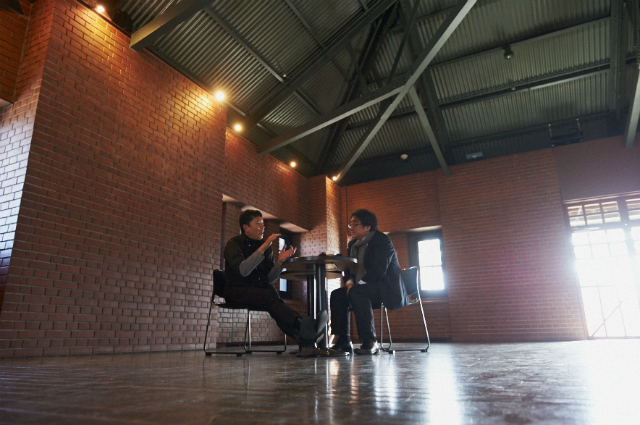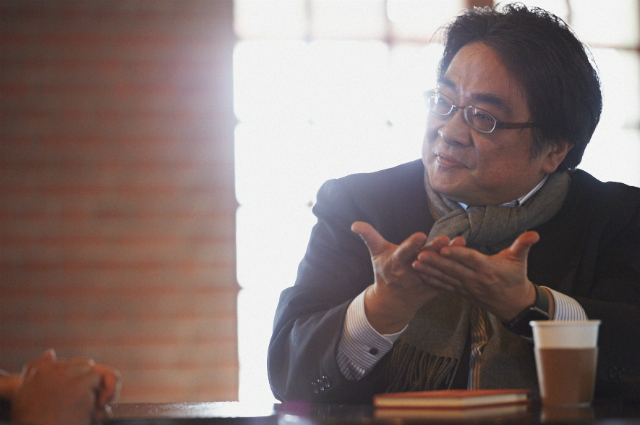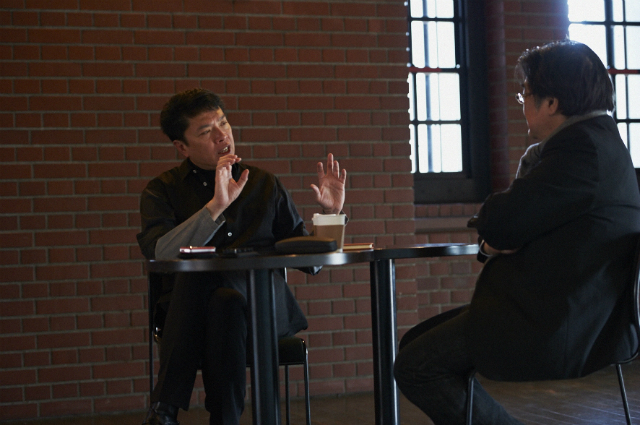
ASIA HUNDREDS is a series of interviews and conference presentations by professionals with whom the Japan Foundation Asia Center works through its many cultural projects.
By sharing the words of key figures in the arts and cultures in both English and Japanese and archiving the "present" moments of Asia, we hope to further generate cultural exchange within and among the regions.
In Search of Singularity
Uchino: You have long been conducting exchange programs with Japan, winning the Arts and Culture Prize of the Fukuoka Prize among many other achievements. However, I thought we could talk about the present and future today. You are currently the Festival Director of Singapore International Festival of Arts [SIFA]. What is your future vision for performing arts in Asia, not just as a festival director or an artist?
Keng Sen: I think I'm searching for singularities or exceptions in my journey through art. This is not a new development——I would say it's something I've always been searching for. The fact that I'm interested in singularities means that I'm no longer interested in cultural exchange per se. I'm interested, among different artists and their activities, in singular artistic communications and visions. So, in a way, all of my previous works and projects may be condensed in the Flying Circus Project [FCP] that I had previously worked on, which first began concentrated in Asia and moved beyond into a larger world. In that sense, those with singular voices exist all across the world and they are not limited to a specific region, to Southeast Asia.
Uchino: Is the geographical definition not as important to you now, then?
Keng Sen: It is less important than before. I think that it was important at a certain stage of my work when I had to understand myself, and, since I'm from Singapore, I was interested in understanding my own "Chineseness" and what China is in relation to other Asian cultures——Indian and Malay ethnicities, Hindu and Muslim cultures and so on——that are present in Singapore. However, I had to go deeper than the topsoil; Singapore is a diaspora country and there are cultures that migrants brought in with them, but the roots are not so deep. So I had to go back to the sources, to the subsoil or bed rocks of these cultures. Throughout the research, therefore, my relationship with Japan was very, very important, because it was Japan's idea of the hana [literally translated as "flower" and the fundamental idea Zeami, one of the founders of Noh, advocated] that encouraged me to search into the depths of culture. Geography is important, but there is a kind of limitation in Asia because of the particular ways politics and its relationships developed in each country: patriarchy, different types and levels of censorship and so on. As a result, Asians may have the tendency to be confined within the specific spaces that they operate in, and, as such, I thought it necessary to not keep my eyes on Asia only.

Uchino: I have actually just read Fredric Jameson's "The Aesthetics of Singularity," so I am interested in the idea of singularity, too. He writes that everything has been flattened out in the globalized world. But rather than lamenting that everything has become equal, he discusses this in a positive tone; that things have become the Other. What art can do in this context is to mark the singularity of a particular moment, and I think this is represented by the form of "installation" in exhibitions and the profession of "curatorship:" the former as that which redefines the longevity of artworks, and the latter as one who establishes relationships within a particular moment. Could your idea of singularity be parallel to Jameson's definition?
Keng Sen: Yes, to a degree. However, don't we still need to anchor ourselves somewhere? Let's just talk about the art world for now, but, for example, the visions of, say, Shuji Terayama in Japan or Sardono Kusumo in Indonesia offered perspectives or anchor points. We need such perspectives precisely because the world continues on the path of globalization ever more rapidly. Anchor points are always seminal, visionary, and singular, even if they grow from a particular creator and in a specific context, they can become trajectories that nurture the future. I think the difference between art and culture lies there: culture surrounds us, but art does not.
What I mean by this is that while there is urban, contemporary, Japanese culture and so forth, artists exist to create a frame and a lens with which to perceive culture. It is then no longer simply a matter of culture, but an artistic vision, many singular artistic visions. The fundamental difference between art and culture, I think, is that art is a particular lens or vision that artists introduce into culture. As such, everything goes back to the individual and the singularity that she/he embodies not as a product of her/his arbitrary fantasy, but as something that develops from within and through the involvement with the socio-historical context(s) she/he lives. For example, the dancer Min Tanaka came to Singapore in 2000 through the Flying Circus Project. It was his first visit to Southeast Asia, and I remember him saying that for a long time he had been afraid to come to Southeast Asia. Although he has frequented Indonesia much since then, that feeling of his――of being afraid to visit――I think, illustrates his particular vision of history, his singularity.

The Philosophy of Singapore International Festival of Arts
Uchino: How, as Festival Director of SIFA, do you materialize your discoveries of singularities or singular artists into the programs?
Keng Sen: The way in which I curate programs is specific to my identity and history as an artist. In that sense, the festival is not a generic model for art business; it does not involve just partnerships or co-productions. I'm interested in three aspects: spotting talent, providing a space for it, and sharing that space and talent with our audience. This is very much linked to my growth as an artist, because I have always tried to work in open spaces and with processes; I have always been driven to communicate with audiences who are interested. This continues to be the basis upon which I create the festival, so it is not about selling art. You can see clearly that in the Dance Archive Boxes [DAB] in 2015, for example. That project had a very specific approach, which I think is a response to the question, "How do you organize a festival?"
Uchino: How do you actually find talent? I ask this because there may be cases where talented "singular" artists may not be appreciated in their own social contexts.

Keng Sen: It does mean that I have to travel a lot and accumulate lived experiences from visiting different cities. I do it this way to search and come into direct contact with talent. Of course, this kind of approach is not possible for everybody. But, as a young adult in Singapore, where art was not given importance, I prioritized spending money, energy, and time on process. There are frequently meetings and conferences related to the arts, but I think that these are somewhat misleading: you feel like you are meeting all kinds of people, but in fact people who are already endorsed by funding bodies. In Singapore, who gets endorsed and who doesn't is quite problematic, I find. So the trips of mine as an individual artist and the entire trajectory I lead prior to being appointed SIFA's director, is, I think, very important; the fact that I did what I did without the National Arts Council saying, "Okay, we'll endorse you so go to Japan."
Uchino: Do you mean that you see the same kind of people in these meetings?
Keng Sen: Yes, I guess.
Uchino: And you rarely encounter something different?
Keng Sen: Right. Traveling is about transforming our frame of mind. The question, "what is contemporary?" is frequently raised, and when it is raised in meetings about contemporary arts, you realize how limited our concepts of contemporaneity are in comparison to other types of meetings about larger social or political issues. Your frame for contemporaneity is transformed when you visit a particular city or village and realize, "Oh, this person may be working on traditional pottery, but her/his thinking is so contemporary." Or sometimes it affects you to a degree that you feel the need to redefine what contemporaneity exactly is. So, I think, meetings have to drill holes into the boundaries and categories that exist everywhere around us. Meetings are important, but I think what is more important are the direct, first-hand encounters.
Uchino: On the other hand, though, I also think that concepts pertaining to art have now become so diverse that there have also been counter movements to protect a certain type of artistic concept. In other words, the notion of "art" has become so different for one person to another it can even feel a little scary to face diversity. In that sense, how has your work been received by audiences in Singapore?
Keng Sen: I think that the most important thing in communicating with the audience is to share your way of thinking with them, that is why, at SIFA we also organize The O.P.E.N. (Open, Participate, Engage, Negotiate), which is a pre-festival of ideas. It is no use advocating singularity without first communicating what exactly you mean by the term. The audience is an "imagined community"――in the Benedict Anderson's sense――which allows us an optimistic view of singularity as that which can be shared and communicated. It is not a question of numbers, but of how the community spreads from here. The O.P.E.N. is important in sharing the space with the audience as an imagined community. SIFA has been a privilege for me to direct, because I think that I'm completely unlike the type of artist the Singaporean government would have wanted. However, at the same time, I think that there has been space within these four years to communicate a specific vision of what the arts can be with this imagined community .

There is currently a superficial, almost cosmetic-like transformation in Singapore; the country appears at first glance to be an open society, but censorship has, in fact, become stricter and it is developing into a neoliberal country of the "first world." As an artist working in this time, I want to make a stand that networking is not art making; that art making is different from mere trends, public relations, or marketing. It is undeniable that art making is relational; it involves the artist's relation to history and people. Despite this, networking, arts management, and marketing continues to dominate our art world. So I think we need to go beyond all of these to find singular voices that have not been tainted by marketing, hyped up trends, or superficial networking. It is very easy to fall into the illusion that you are making art when, in fact, you are simply networking. So it is very important not to confuse the two.
Uchino: Have you thought of extending your term as the artistic director of SIFA?
Keng Sen: No, I don't want to. That precisely is "singularity," right? Government officials, both in Japan and in Singapore, have often asked me, "is the festival director almighty?" to which I would respond, "no, I don't think so. I actually think it is important that there be no curatorial committee. It's important that the festival is the director's singular vision." With that said, however, this singularity must also come to an end, because SIFA is a city festival and therefore needs to be constantly renewed; it must not forever remain as the singular vision of one particular person. Ironically this singularity safeguards the public space, for the arts is the public space or we will just end up into monopolies. Hence I also think that it should be four or five years per term. Generally, in Europe for example, an artistic director's term is around five years, which I think, can be renewed only once. In fast-transforming societies like Asia, ten years is simply too long. If you are a "singular" individual, you could be compromised if you stay longer than five years in one place.
Uchino: Going back to Asia, you mentioned the deterioration of Asia's artistic environment. I understand China doesn't necessarily represent that situation, but what do you think of the future of young artists in Southeast Asia or South Asia?
Keng Sen: I think it's important to stick to your independence in different ways. Independence is, of course, very dangerous. People sometimes tell me, "you can afford to be independent because of your economic situation" or "because you're now powerful enough." There are those whom the networks, governments, and funding bodies love. My advice to younger artists would be get out of your original contexts and gain an inside and outside perspective on what you are doing. They should try to get funding, but they should not depend on it alone. At the same time, though, they mustn't be satisfied by simply moving around like a nomad; movement must lead to artistic practice and creation because to make art is to also consider economic efficiency. So you must travel, and then stop to make art. Then you can travel again and stop again. So in a sense I do advocate inefficiency in art processes. You also need to be careful about how you travel; how you maintain your mobility and how you can continue without compromising your methods.

- Next Page
- Japan and Asia






